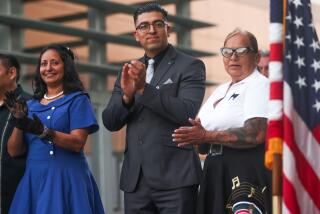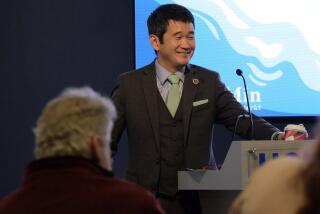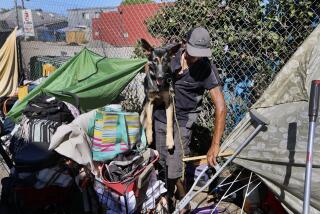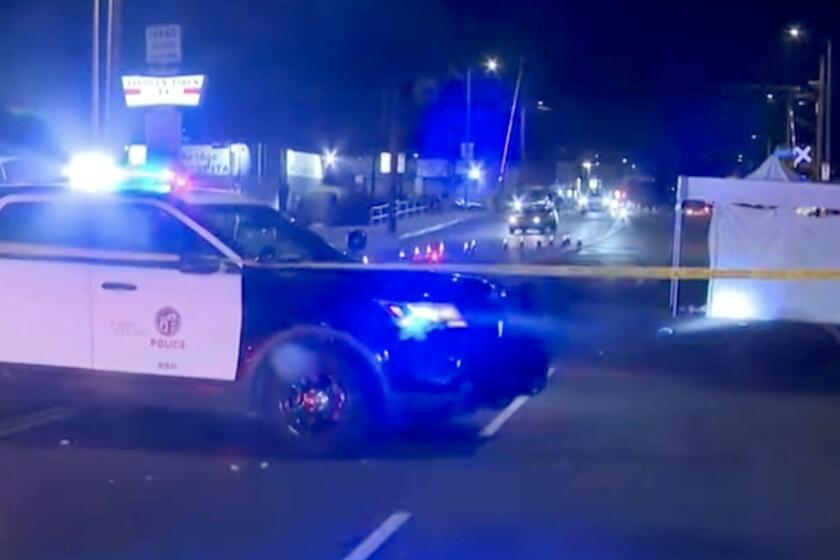Dunn and Garcia face off in runoff for Long Beach mayor
It’s been decades since anyone could credibly refer to Long Beach by its once proudly held moniker, “Iowa by the Sea.”
The city earned the nickname in the early 1900s, when waves of Midwesterners flocked to its sun-soaked shore and thousands turned out for its annual Iowa picnic. In 1960, Long Beach was 95% white and mostly middle-class.
Today, more Latinos live in Long Beach than whites, the city hosts one of the nation’s largest annual gay pride parades, and it is home to the largest Cambodian American community in the nation, according to census data.
But as Long Beach voters prepare to go to the polls Tuesday, they’ll also confront another major distinction: For the first time ever, the mayor of this seaside metropolis will almost certainly be black or Latino.
In a runoff election, real estate investor and former NFL player Damon Dunn, 38, is facing Councilman Robert Garcia, who at 36 would become the youngest and first openly gay man to hold that office. Some observers say the winner could help forge a new image of the city, whose bustling port and up-and-coming urban core have always existed in the shadow of Los Angeles.
“There is a level of symbolism there that Long Beach has turned a corner,” said professor Christine Jocoy, who teaches geography at Cal State Long Beach and has studied social equity and sustainability issues in the city.
In many ways, Long Beach politics has been rounding that corner for years, attracting a newer cohort of younger, progressive politicians and a diverse array of council members. Aside from Garcia, the nine-member panel includes three blacks, a lesbian and an Indian American who immigrated to California at the age of 7.
The number of Republicans in Long Beach has steadily declined over the last decade, while the ranks of registered Democrats have swelled by 30%, according to voter registration data.
But in the city’s 106-year history, all but two of Long Beach’s mayors have been white men.
Political observers caution that such symbolism is a far cry from a political earthquake.
Nearly half of all voters who turned out during the April primary live in the largely white, wealthy eastside districts that include trendy Belmont Shore, Naples and upscale enclaves surrounding El Dorado Park.
In the working-class westside districts where the highest concentrations of blacks and Latinos live, turnout was dismal, hovering around 2% in some areas.
And with 10 candidates in the primary, Garcia and Dunn benefited from a split of the progressive vote among several front-runners and city insiders, garnering 25.4% and 22.3%, respectively.
Dunn, a former Republican and relative newcomer to the city, has cast himself as an outsider with a rags-to-riches story and sharp business know-how, earning the endorsements of the city’s Chamber of Commerce and firefighters union. He has raised more than $1 million, much of it his own money, and outside groups have spent an additional $340,000 to help get him elected.
Garcia, elected to the council in 2009, has been endorsed by a long list of Democratic legislators and union groups, as well as current Mayor Bob Foster, Los Angeles Mayor Eric Garcetti, and Bonnie, Alan and Suja Lowenthal, all members of a prominent Long Beach political family. Garcia has raised $454,000 during the primary and general election, with hundreds of thousands more spent on his behalf by unions and other interest groups.
In total, fundraising by candidates and independent expenditures in the mayor’s race alone has topped $2.8 million, the highest in city history. On Tuesday, Long Beach voters will also decide races for city attorney and Council Districts 1 and 5.
When the mayor and five new council members take office, they will be charged with overseeing a number of major projects, including a proposed new downtown civic center, efforts to reduce air pollution on the city’s westside and $4.5 billion in infrastructure upgrades over the next decade at the Port of Long Beach.
Such thorny issues as rising pension costs and how best to regulate medical marijuana dispensaries also await.
Garcia has said he wants to transform Long Beach into a “Silicon Valley of the South” — ignoring the fact that L.A.’s Westside has claimed the mantle of “Silicon Beach” — and has pledged to work with Los Angeles on projects including greening the L.A. River and attracting more local filming.
Dunn promises to jump-start the local economy by streamlining education and job-training programs, and to ask for looser regulations to fast-track port projects.
Once the site of a major U.S. Navy shipyard, Long Beach first retooled its port as a regional trade workhorse. More recently, leaders have tried to shed some of its industrial identity by focusing on urban renewal.
Various leaders have suggested demolishing the breakwater to attract surf-seeking tourists, luring back the flagging aerospace industry, and even bringing back a storied roller coaster to the waterfront.
But the city’s great strides toward a new identity haven’t fully jelled.
After the Navy’s departure, city leaders spearheaded the transformation of its gritty downtown, replacing seedy bars and tattoo parlors with high-rise hotels and condominiums.
The arrival of Metro’s Blue Line gave it potential as a commuter-friendly locale for the hip, urban employee, as did miles of dedicated bicycle lanes lauded by urban planners. Restaurants and cafes began to spring up in the once-empty corridor, as did pocket parks.
“Its coolness factor has clearly been waxing over time,” said Brian D. Taylor, a professor of urban planning at UCLA’s Luskin School of Public Affairs.
But, Taylor added, such gains are often seen through the lens of a so-called second-city syndrome, referring to Long Beach’s neighbor, Los Angeles.
Also, the recession slowed the city’s progress, and empty storefronts still sit near gourmet pizza restaurants and upscale cocktail bars.
“Whether it limps along in that middle ground … remains to be seen,” Taylor said.
More to Read
Sign up for Essential California
The most important California stories and recommendations in your inbox every morning.
You may occasionally receive promotional content from the Los Angeles Times.











